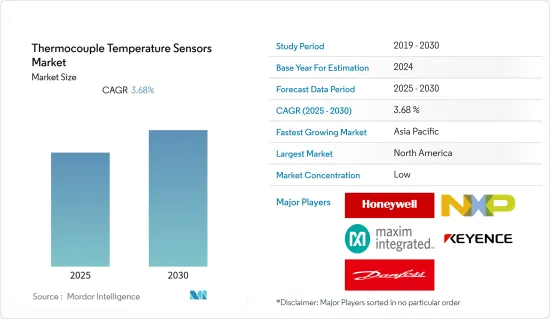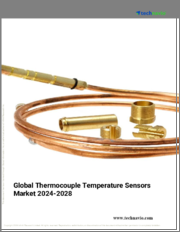
|
시장보고서
상품코드
1636621
열전대 온도 센서 시장 : 점유율 분석, 산업 동향 및 통계, 성장 예측(2025-2030년)Thermocouple Temperature Sensors - Market Share Analysis, Industry Trends & Statistics, Growth Forecasts (2025 - 2030) |
||||||
열전대 온도 센서 시장은 예측 기간 동안 CAGR 3.68%를 기록할 전망입니다.

주요 하이라이트
- 게다가 세계의 센서 시장에서 첨단 기술의 도입과 산업계에서의 디지털 변혁의 끊임없는 증가 추세로 인해 센서, 특히 스마트 센서에 대한 수요가 높아지고 있습니다.
- 열전대 온도 센서는 주로 자동차 산업의 열 관리 및 자동 변속기 시스템에 사용됩니다. 따라서 자동차의 엄격한 배기가스 규제, 자율주행차의 적극적인 시장개척, 전기자동차(EV)의 세계 보급 확대 등이 시장 성장을 가속하는 주요 요인이 되고 있습니다. 예를 들어 인도 정부는 2030년까지 자동차의 30% 이상을 전기차로 만들기 위해 충전 인프라와 정책 프레임워크 구축에 주력하고 있습니다.
- 2019년 2월 ST 마이크로 일렉트로닉스는 현대 Autron과 파트너십을 체결하여 친환경 자동차 센서 솔루션 개발 실험실을 시작했습니다. 이 제휴에 의해 파워트레인 컨트롤러를 중심으로 친환경 자동차를 위한 선구적인 솔루션을 엔지니어가 공동으로 개발할 수 있는 환경이 갖추어집니다.
- 그러나 극한 상태에서의 센서와 가열 문제에 대한 기술적 인식이 시장 성장을 방해하는 주요 억제요인이 되고 있습니다.
열전대 온도 센서 시장 동향
자동차 산업이 큰 성장을 기록할 전망
- 지능형 센서 기술의 소형화로 스마트 자동차 장비의 안전성과 정밀 측정, 적시에 센서 데이터의 분석 및 생성을 위한 온도 센서의 요구가 증가할 것으로 보입니다. 이러한 이유로 이 용도에서 열전대 온도 센서에 대한 수요가 증가할 것으로 예상됩니다.
- 또한 자동 온도 제어(ATC)는 대부분의 전기자동차 및 중급 부문의 하이엔드 모델에서 일반적인 기능입니다. 미국, 독일, 중국 등 가처분 소득이 높은 지역에서 전기자동차 판매가 증가하고 있으며 열전대 온도 센서 시장의 성장 기회가 되고 있습니다.
- 자동차 부문에서 여러 장치를 충전하는 데 사용되는 배터리 충전은 자율주행 차량에 많이 사용되는 배터리의 일반적인 문제이므로 가열 문제를 정기적으로 점검하고 모니터링하는 온도 감지 소자를 갖추고 있습니다. 이는 장치의 수명을 연장하고 손상을 줄일 수 있습니다. 이에 따라 배터리가 충분히 충전되었는지 확인할 수 있습니다.
- 전기차의 생산량 증가는 열전대 온도 센서 수요를 촉진할 것으로 예상됩니다.
북미가 가장 큰 시장 점유율을 차지
- 열전대 온도 센서 시장에서는 미국이 돌출한 점유율을 차지할 것으로 예상됩니다. 이 나라는 세계 최대의 자동차 시장으로, 13개 이상의 주요 자동차 제조업체가 존재합니다. 미국에서는 전기자동차의 보급이 급속히 진행되고 있으며, 미국 시장에서의 자동차 판매 대수의 1%는 전기자동차로 추정되고 있습니다.
- 캘리포니아는 전기자동차(EV) 판매로 미국 시장을 독점하고 있습니다. 캘리포니아 주 제로 방출 차량(ZEV) 프로그램은 이 주의 자동차 제조업체들에게 일정 비율의 전기자동차 판매를 의무화함으로써 EV 수요를 촉진하고 있습니다. 미국 자동차 시장은 합리적인 가격의 EV를 확대하기 위해 자동차 제조업체에 더 많은 압력을 가할 것으로 보입니다. 따라서 이 나라의 열전대 온도 센서 수요에 박차를 가하고 있습니다.
- 게다가 미국 항공우주 제조업체들은 국제 경쟁이 심합니다. 2017년 항공우주산업은 미국 경제에 1,430억 달러의 수출 매출을 기여했습니다. 보잉과 같은 항공우주 부문의 기업들은 2018년 120억 달러 상당의 계약을 받았으며 아메리칸 항공에 신형 제트기 787 드림 라이너 47기를 공급했습니다. 마찬가지로 이 회사는 2017년 싱가포르 항공과 138억 달러 상당의 신형 와이드 바디 제트기 39대 납품 계약을 맺었습니다. 위의 동향은 이 나라에서 열전대 온도 센서 수요를 촉진할 것으로 예상됩니다.
열전대 온도 센서 산업 개요
열전대 온도 센서 시장은 경쟁이 심하고 여러 주요 기업으로 구성되어 있습니다. 주요 기업으로는 Texas Instruments Inc., STMicroelectronics, Honeywell International Inc., Danfoss Group 등이 있습니다. 이러한 기업들은 시장 점유율과 수익성을 높이기 위해 전략적 협력 이니셔티브를 활용합니다. 시장에서 사업을 전개하고 있는 기업은 또한 제품 능력을 강화하기 위해 열전대 온도 센서 기술에 종사하고 있는 신흥 기업을 인수하고 있습니다.
- 2019년 1월-Honeywell Home은 두 개의 새로운 T-Series 스마트 서모스탯을 발표했습니다. 새로운 서모스탯과 이전 T-Series 모델 간의 가장 큰 차이점은 가정 내 온도의 균형을 맞추고 우선순위를 매기는 무선 스마트룸 센서의 지원입니다. 스마트 룸 센서는 온도, 습도 및 움직임을 모니터링하고 그 정보를 사용하여 가정 내의 다른 지역에 우선 순위를 부여합니다. 우선순위를 설정하면 어떤 방이 가장 중요한지 설정할 수 있습니다. 냉난방 시스템 전체가 관리되므로 우선 순위가 높은 방과 지역의 온도와 습도가 우선 순위가 낮은 장소보다 우선합니다.
기타 혜택 :
- 엑셀 형식 시장 예측(ME) 시트
- 3개월간의 애널리스트 서포트
목차
제1장 서론
- 조사의 성과
- 조사의 전제
- 조사 범위
제2장 조사 방법
제3장 주요 요약
제4장 시장 역학
- 시장 개요
- 시장 성장 촉진요인 및 억제요인 서문
- 시장 성장 촉진요인
- 보안 및 감시 동향 증가
- 급속한 기술 개발
- 시장 성장 억제요인
- 종래의 온도 센서 기술의 우위성
- 밸류체인 및 공급망 분석
- 업계의 매력도-Porter's Five Forces 분석
- 신규 진입업자의 위협
- 구매자 및 소비자의 협상력
- 공급기업의 협상력
- 대체품의 위협
- 경쟁 기업간 경쟁 관계의 강도
제5장 시장 세분화
- 용도별
- 음식
- 발전
- 자동차
- 석유화학 및 화학
- 석유 및 가스
- 금속 및 광업
- 항공우주
- 기타 용도(플라스틱, 상하수도 관리, 전기, 생명과학)
- 지역별
- 북미
- 미국
- 캐나다
- 유럽
- 독일
- 영국
- 프랑스
- 기타 유럽
- 아시아태평양
- 중국
- 일본
- 인도
- 한국
- 기타 아시아태평양
- 라틴아메리카
- 중동 및 아프리카
- 북미
제6장 경쟁 구도
- 기업 프로파일
- Maxim Integrated Inc.
- Keyence Corporation
- NXP Semiconductors NV
- Honeywell International Inc.
- Danfoss Group
- Texas Instruments Inc.
- Microchip Technology
- STMicroelectronics
제7장 투자 분석
제8장 시장 기회 및 향후 동향
AJY 25.02.12The Thermocouple Temperature Sensors Market is expected to register a CAGR of 3.68% during the forecast period.

Key Highlights
- Further, the introduction of advanced technologies in the global sensors market, along with the constantly growing trend of digital transformation in the industrial world, has resulted in the rising demand for sensors, especially for smart sensors.
- Thermocouple temperature sensors are mainly used for thermal management and automatic transmissions systems in the automotive industry. Therefore, the stringent emission norms for automobiles, aggressive development in an autonomous vehicle, and increasing penetration of electric vehicle (EV), globally, are some of the major factors driving the market growth. For instance, the Indian government is focusing on creating charging infrastructure and policy framework, so that by 2030, more than 30% of vehicles are electric vehicles.
- In February 2019, STMicroelectronics' entered into a partnership with Hyundai Autron, to launch a development lab for eco-friendly automotive sensor solutions. The collaboration will provide the environment for engineers to collaborate on pioneering solutions for eco-friendly vehicles, with a focus on powertrain controllers.
- However, technical awareness about sensor and heating issues in the extreme condition is the key restraints which hamper the market growth.
Thermocouple Temperature Sensors Market Trends
Automotive Industry is Expected to Register a Significant Growth
- The need for temperature sensors for safety and precision measurements of the smart automotive equipment, to analyze and produce timely sensor data, is likely to increase because of the miniaturization of the intelligent sensor technology. This is expected to fuel the demand for thermocouple temperature sensors in this application.
- Further, Automatic Temperature Control (ATC) is a common feature in most of the electric vehicles and high-end models in the mid-range segment. The increased sales of electric vehicles among high disposable income regions, such as the United States, Germany, and China, provides an opportunity for the growth of the thermocouple temperature sensors market.
- The battery charges used for charging multiple devices in the automotive segment are equipped with temperature-sensing elements that regularly check and monitor heating issues, as this is a common problem with batteries mostly used in automated vehicles. This helps in increasing the life of devices and decreases damage. Thereby, ensuring that the batteries are sufficiently charged.
- The increasing production of electric vehicles is expected to drive the demand for thermocouple temperature sensors.
North America Holds the Largest Market Share
- The United States is expected to have a prominent share in the thermocouple temperature sensor market. The country is one of the largest automotive markets in the world and is home to over 13 major auto manufacturers. Electric vehicle use in the United States has risen rapidly, with an estimated 1% of automotive sales in the US market for electric vehicles.
- California dominates the US market in terms of sales of electric vehicles (EVs). It's Zero Emission Vehicle (ZEV) program is driving the demand for EVs, by requiring automakers in the states to sell a certain percentage of electric cars. The US auto market is likely to further pressurize automakers to expand their affordable EV offerings. Hence, fueling the demand for thermocouple temperature sensors in the country.
- Further, US aerospace manufacturers are very competitive internationally. In 2017, the aerospace industry contributed USD 143 billion in export sales to the US economy. Companies in the aerospace sector, such as Boeing, won contracts worth USD 12 billion in 2018, to supply 47 new 787 Dreamliner jets to American Airlines. Similarly, the company signed a deal with Singapore Airlines for the delivery of 39 new wide-body jets, worth USD 13.8 billion, in 2017. The above-mentioned trends are expected to drive the demand for thermocouple temperature sensors in the country.
Thermocouple Temperature Sensors Industry Overview
The thermocouple temperature sensors market is highly competitive and consists of several major players. Some of the key players areTexas InstrumentsInc.,STMicroelectronics,Honeywell InternationalInc.,Danfoss Group, among others.These companies are leveraging their strategic collaborative initiatives to increase their market share and profitability.The companies operating in the market are also acquiring start-ups working on thermocouple temperature sensortechnologies to strengthen their product capabilities.
- January 2019 - Honeywell Home introduced two new T-Series smart thermostats. The greatest difference between the new thermostats and earlier T-Series models is support for wireless Smart Room Sensors to balance and prioritize temperature in the home. Smart Room Sensors monitor temperature, humidity, and motion and use that information to prioritize different areas in a home. Prioritizing lets you configure which room or rooms are most important. The entire heating and cooling system will be managed, so the temperature and humidity in the higher priority rooms and areas take precedence over lower priority locations.
Additional Benefits:
- The market estimate (ME) sheet in Excel format
- 3 months of analyst support
TABLE OF CONTENTS
1 INTRODUCTION
- 1.1 Study Deliverables
- 1.2 Study Assumptions
- 1.3 Scope of the Study
2 RESEARCH METHODOLOGY
3 EXECUTIVE SUMMARY
4 MARKET DYNAMICS
- 4.1 Market Overview
- 4.2 Introduction to Market Drivers and Restraints
- 4.3 Market Drivers
- 4.3.1 Rising Trends of Security and Surveillance
- 4.3.2 Rapid Technological Developments
- 4.4 Market Restraints
- 4.4.1 Dominance of Legacy Temperature Sensor Technologies
- 4.5 Value Chain / Supply Chain Analysis
- 4.6 Industry Attractiveness - Porter's Five Forces Analysis
- 4.6.1 Threat of New Entrants
- 4.6.2 Bargaining Power of Buyers/Consumers
- 4.6.3 Bargaining Power of Suppliers
- 4.6.4 Threat of Substitute Products
- 4.6.5 Intensity of Competitive Rivalry
5 MARKET SEGMENTATION
- 5.1 By Application
- 5.1.1 Food and Beverage
- 5.1.2 Power Generation
- 5.1.3 Automotive
- 5.1.4 Petrochemicals and Chemicals
- 5.1.5 Oil and Gas
- 5.1.6 Metals and Mining
- 5.1.7 Aerospace
- 5.1.8 Other Applications (Plastics, Water and Wastewater Management, Electrical, Life sciences)
- 5.2 By Geography
- 5.2.1 North America
- 5.2.1.1 United States
- 5.2.1.2 Canada
- 5.2.2 Europe
- 5.2.2.1 Germany
- 5.2.2.2 United Kingdom
- 5.2.2.3 France
- 5.2.2.4 Rest of Europe
- 5.2.3 Asia Pacific
- 5.2.3.1 China
- 5.2.3.2 Japan
- 5.2.3.3 India
- 5.2.3.4 South Korea
- 5.2.3.5 Rest of Asia Pacific
- 5.2.4 Latin America
- 5.2.5 Middle East and Africa
- 5.2.1 North America
6 COMPETITIVE LANDSCAPE
- 6.1 Company Profiles
- 6.1.1 Maxim Integrated Inc.
- 6.1.2 Keyence Corporation
- 6.1.3 NXP Semiconductors NV
- 6.1.4 Honeywell International Inc.
- 6.1.5 Danfoss Group
- 6.1.6 Texas Instruments Inc.
- 6.1.7 Microchip Technology
- 6.1.8 STMicroelectronics











